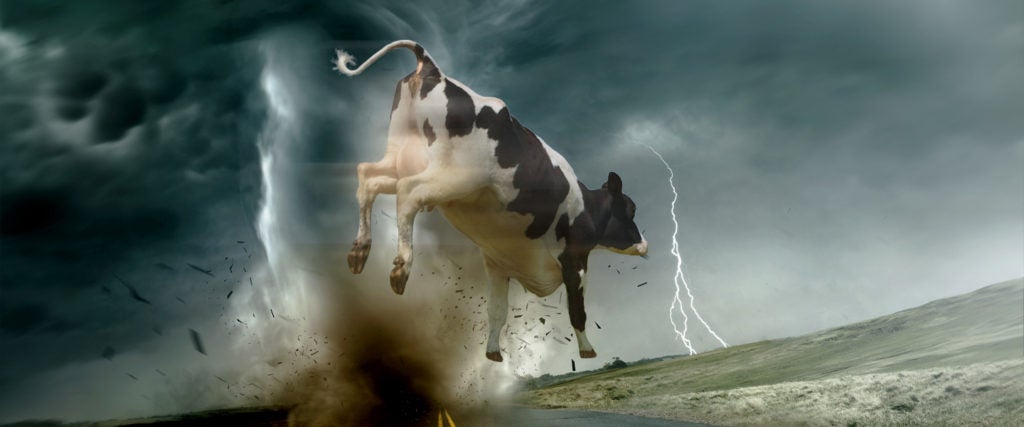It’s been years since I’ve seen the movie, but sometimes I still think about that cow from Twister. Did she survive the tornado? If so, did she ever find her owner and become reunited with her cow friends? Or did she spend the rest of her years wandering the plains of Oklahoma in search of her home?
But I don’t just wonder about post-tornado cow — I’m also curious about her life before we see her in Twister. Did she lead a happy life before then? Or is the existence of a cow such a miserable slog that the tornado ride may have been the best moment of her life?
To start things off, I had to determine what kind of cow that was in Twister. I quickly determined that she was a Holstein-Friesian, which are dairy cows. According to New York cattle farmer Sam Sweetman, the gestation period for cows is the same as humans, so after nine months in her mama cow’s womb, he says that baby cows are usually born in a barn and that their birth is assisted by the farmer. After about six to eight weeks, they’re put on solid foods and allowed to roam on the pasture with other cows.
“At about 16 to 18 months of age, they get artificially inseminated for the first time,” Sweetman continues. Nine months after that, they begin lactating having given birth, which is when a dairy cow starts producing milk. “About 80 to 100 days after they give birth, the cow is inseminated again,” Sweetman says. “The ideal cycle for a dairy cow is that they produce milk for 305 days, get a rest of 60 days, and then give birth and begin producing milk again. In order for them to be profitable, they have to have a calf every year.”
Generally, Sweetman says the ideal situation is that you can get five periods of lactation out of a cow, and you may even be able to get eight or nine seasons out of them, but oftentimes, they only last two or three seasons due to the stress. Once they’re no longer giving birth and producing milk, Sweetman says, “they go to the auction and they end up at McDonald’s.”
Before they end up in Ronald McDonald’s meat grinder though, Sweetman explains that the average day for a dairy cow consists of two milkings per day, the first around four in the morning, then again in the afternoon. They also eat around four to five times a day and get plenty of sleep, which they do lying down most of the time (and often with their eyes open).
It was likely on a normal day like this that the cow in Twister was suddenly taken on the ride of her life. This kind of thing does happen in real life, explains meteorologist Katie Nickolaou from KMEG in Sioux City, Iowa. “I remember reading a story about a tornado that hit this pond and picked up a bunch of frogs and fish, and it dumped them on top of a town, so it was actually raining fish and frogs. That can also happen with cats, dogs, horses and even cows. These storms pick up trains, so it’s only natural that they’d pick up animals,” she explains.
While up in the air, Nickolaou tells me that the cow could have reached speeds from 80 to 180 miles per hour, as that tornado — since it formed over water — was technically a waterspout, and that’s about top waterspout speed. Nickolaou also says, after doing some cow-culations, that the cow could have been thrown up to a quarter mile away from wherever it was picked up. More than likely, that cow drowned in the water where the waterspout formed, but Nickolaou says that a waterspout can become a tornado and move onto land, so the cow conceivably could have survived had she landed on solid ground. “The most dangerous part of a tornado is the debris,” says Nickolaou, “and if they’re just in an open field and the tornado doesn’t pick up the rocks and stones and trees that could injure or impale a cow, feasibly, a cow could survive.”
Had she survived, the cow’s life could have taken one of two paths from that point. If she had a serious injury, like a broken leg, bovine veterinarian John Nelson, who works for the Kansas Department of Agriculture, says that she most likely would be euthanized. Sweetman says an injured cow may become “dog food,” but Nelson insists that no euthanized cow would be consumed — instead, it might be buried, cremated or turned into compost.
If the cow had no injury, or only minor scrapes and cuts, she would likely be returned to her farm, as Sweetman says that cows are tagged now as opposed to being branded, so it’s easy to tell where they came from. From there, she might return to her routine of early mornings and artificial inseminations, or she might be forever rattled by the experience, in which case she may never lactate again, which would land her in an auction and eventually as part of a Travis Scott Meal.
And so, though I originally fantasized about the cow surviving the experience to brag about it to her barn-mates later on, I now hope that she did die from a swift, merciful rock to the skull, as every other scenario for her post-tornado is depressingly bleak. Really, the best-case scenario for that cow was a quick, painless death after soaring through the air like a bird. I just hope she milked the experience for everything it was worth.

